Sportboat Buying: 10 Check Points: #3
When buying a boat, it's easy to get wrapped up in engine choices, but don't forget the other end of the performance system: the drive unit itself. Each manufacturer offers a selection of drives to fit its engines, and choosing the correct one for the way you'll use your boat, and that matches your own driving style, will make a big difference in your enjoyment of your new boat. While you don't have to become a marine engineer to pick a drive unit, some basic knowledge will help.
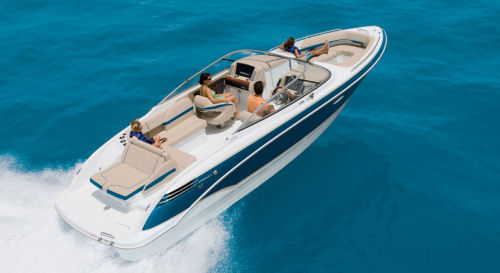 Most sportboats, like this Formula 270, carry sterndrives under their engine covers. Choosing the engine is important, but don't forget: You often have choices of drive, too. |
Check Point #3: Propulsion Drive Systems:
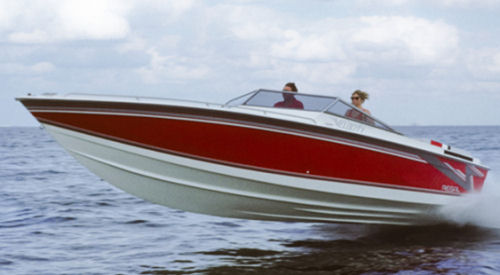 If you drive your boat like this (she's a Regal Velocity 30 from about 1990, a pleasure version of a successful raceboat of the day), you'll want heavy-duty drives. Wave-jumping stresses the drive when the prop drops back into solid water. |
A. What Type of Drive is Best?
There are three basic types of drive systems to choose from, although most boats are designed and built for one specific system. A few sportboats offer outboard power. Outboards combine the engine and drive in one unit, and unless they're modifying the engine for racing most folks take the lower unit that comes with the motor and are happy with it. We're not talking raceboats here, so we'll move on....
 Evinrude's E-TEC 225 H.O. is a fine outboard, but you're more likely to find one aboard a center-console or a high-performance speedboat than on a sportboat's transom. |
Inboards, whether straight or V-drive, spin shafts and props, steer with a rudder, and the only real choice boaters have to make is the propeller. Choosing the correct prop is part engineering, part science and part voodoo, and best left to experts. Few sportboats run shafts and props, so we're not spending time on them here, either.
 Inboards are common aboard dedicated ski and wakeboard boats like this Tigé Z1, but most sportboats are powered with sterndrives. |
While a couple of builders offer sportboats powered by waterjets, most have sterndrives under their engine covers. A sterndrive combines an inboard engine with an external drive, similar to the lower unit of an outboard motor. The drives can be tipped-up to let the boat sneak into shallow water without risking the underwater gear; they create less drag than the shaft, prop and rudder on a conventional drive, and consequently produce higher speeds; and – a big advantage over shafts -- they can be trimmed in or out while underway, changing the running attitude of the boat.
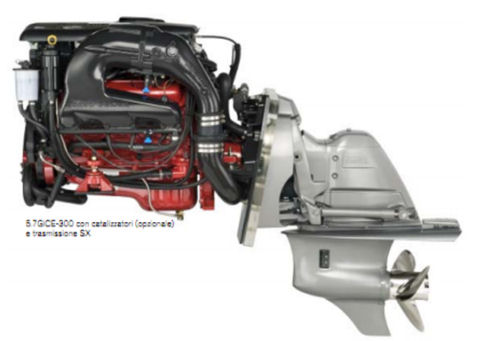 Volvo Penta's 320-hp 5.7GiCE, here matched to a single-prop Aquamatic drive, is a popular powerplant for sterndrive boats, in single and twin installations. Torque steer, caused by variations in water pressure on the blades as the propeller rotates, can be an issue with any single-prop drive, as it can be with OBs and inboard engines, too. |
B. How Many Props?
Each engine builder also builds drives to match, so when you choose an engine you're also choosing the drive, or at least the brand of drive. But all manufacturers build a selection of drives to fit their motors, the main differences being in the number of props per drive and the strength of the drive's internal parts – a drive married to a high-torque diesel, for example, has to have high-strength innards.
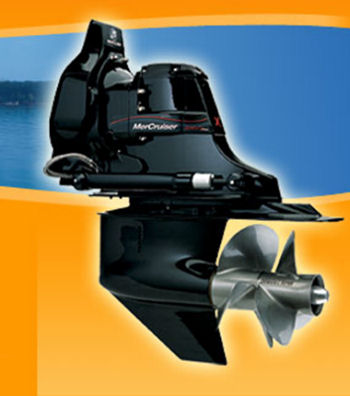 MerCruiser's Bravo Three drive has counter-rotating props, which make the drive more efficient and negate torque steer caused by a single prop. Volvo Penta invented the dual-prop drive - they call their the dDoprop. |
Single-engine sportboats often have either single-prop or dual-prop drives as options. If possible, we recommend dual-prop drives: They are more efficient; will usually make the boat go faster at top speed and enable it to cruise at lower rpms; and will let the boat track better, particularly at idle, because the counter-rotating props cancel out the effects of torque. These lower units are heavy-duty and cost more than standard single-prop drives.
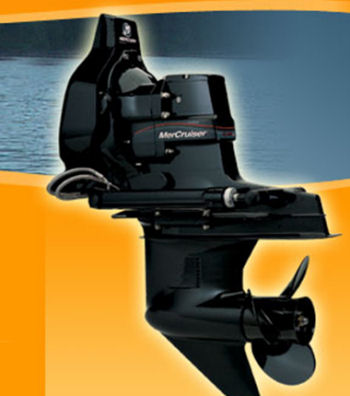 The MerCruiser Alpha One is a workhorse stern drive for smaller boats, and will match up with engines to 300-hp. This drive is less popular today than in years past, now superseded by the Bravo One, Two and Three, but it's still a rugged, reliable drive unit. |
In twin-engine installations, the drives are set to spin in opposite directions, which also counters torque steer. Dual-prop drives are less important here, although they are still more efficient. Be certain any twin-screw boat you buy has counter-rotating props – today, every one that's properly engineered will, but that wasn't always the case: As recently as the 1980s, twin sterndrive boats often had both props spinning in the same direction, which made steering a challenge. If you're shopping for an older sportboat to rehab, keep an eye open for this.
C. What Brand of Drive?
Most sterndrive boats are powered by either Volvo Penta or MerCruiser engine/drive packages. There are other drives on the market – Konrad builds heavy-duty drives primarily for racing applications, for example, and Yanmar builds a drive to match their diesels – but for the most part, you'll be choosing between Volvo Penta and MerCruiser. Both manufacturers produce excellent, reliable drives, so unless you have your heart set on one or the other, it's not really a problem. If the boat you like has a drive system of either brand, go with it and don't worry. If you have a choice, pick the brand with the nearest service center - eventually you'll need parts or service.
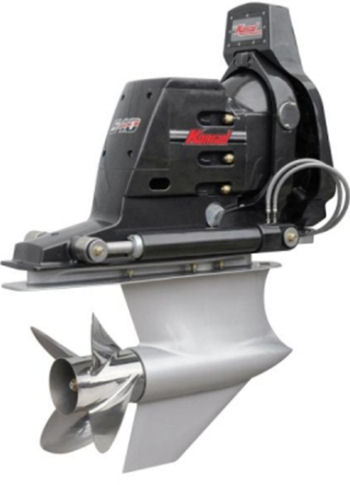 The Konrad Marine 540 PRS sterndrive is a replacement for MerCruiser's rugged TRS drives, once favorites of the raceboat crowd. It's more drive than most boaters need. |
In the early 1960s, when they still called sterndrives "inboard/outboards," OMC (Outboard Marine Corporation) was also a player. At that time builders of Evinrude and Johnson outboards, OMC used a different basic design than Volvo and MerCruiser, one that proved not as reliable or popular. In the early 1990s OMC created the Cobra sterndrive to compete once again with the Big Two, but without success. By the mid-90s the Cobra drive was gone.
However, if you're shopping for a classic sportboat to rehab, you might run across one with OMC power. Parts are still available for these engines and drives, but unless you're a stickler for authenticity, we recommend repowering with Volvo or MerCruiser. You'll have a more reliable package.
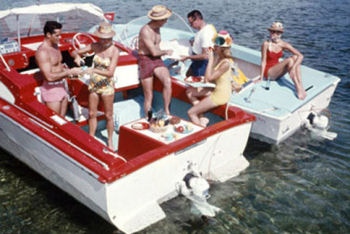 This was the scene in the late 1950s, when Volvo Penta introduced the first Aquamatic stern drives. The scary thing is, some of us at BoatTEST.com remember these days! |
D. Is a Joystick Necessary?
Joysticks are all the rage today, linked to sterndrives or pods; to read the magazines, you'd think nobody could handle a boat without one. But while large sportboats powered by twin engines can also be equipped with joystick software, it's an expensive option (but for many people a compelling one).
Some larger sportboats also have a bow thruster option. A thruster combined with conventional sterndrives, either single or twins, makes a nice-handling package at much less cost than joystick control.
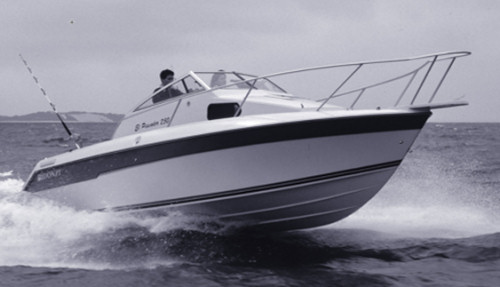 Consumers should bear in mind that boaters have operated their single and twin-engine sportboats for over 45 years without joysticks and bow thrusters. This single-sterndrive Donzi El Pescador from the mid-1980s had neither, but handled just fine under a skilled skipper. |
Our Advice
In a nutshell, here's our advice: Choose whichever engine fits your sportboat needs without sweating over the drive. The major sterndrive engine builders all produce excellent drives.
Follow the manufacturer's advice for matching drives to engines; they know what works with what, and since they have to honor the warranty will ensure the two parts play nicely together. Don't try to second-guess their engineers by demanding a combination not on the options list.
Choose a dual-prop drive if possible. You'll get better performance and handling from idle through top speed. It's even more important in single-screw applications.